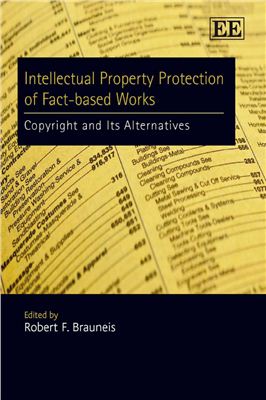Издательство Edward Elgar, 2009, -361 pp.
The chapters in this book are based on papers presented at a symposium entitled ‘Feist, Facts, and Functions: IP Protection for Works Beyond Entertainment’, which was held in Washington, DC on 28 September 2007. The symposium was co-sponsored by The George Washington University Law School and the Software and Information Industry Association. For their support of the project, I would like to thank Frederick M. Lawrence, the Dean of the Law School; Michael Ryan, Director of the Law School’s Creative and Innovative Economy Center; Ken Wasch, President of the Software and Information Industry Association; and Keith Kupferschmid, Senior Vice President of the Association. For their aid in organizing and staffing the event, I would like to thank Sarah Huisentruit Orye, Shauna Eisenberg, and Thomas Lee of the Creative and Innovative Economy Center. For his superlative assistance in compiling the indices, I would like to thank David Yung Ho Kim, whose work was generously supported by the Cardozo Law School during my visit there in the Spring of 2009; for his timely support in finalizing the indices, I would like to thank Thomas Mittenzwei. Finally, and most importantly, I would like to thank the participants in the Symposium for their presentations and for their subsequent contributions to this volume, from which I have leaed a great deal.
Part I Copyright and Facts: Historical and Comparative Perspectives
Feist, facts and functions: historical perspective
The debate over copyright in news and its effect on originality doctrine
Of silos and constellations: comparing notions of originality in copyright law
Part II The Fact: A Contested Concept
Two fallacies about copyrighting factual compilations
Speaking of the world: fact, opinion and the originality standard of copyright
Created facts and their awkward place in copyright law
Copyright and convergence: a pragmatic perspective
Part III Alteatives to Copyright: Trade Secret, Tort, and Sui Generis Protection of Facts
The challenge of protecting trade secret information in a digital world
The third party problem: assessing the protection of information through tort law
The componentization of information
The chapters in this book are based on papers presented at a symposium entitled ‘Feist, Facts, and Functions: IP Protection for Works Beyond Entertainment’, which was held in Washington, DC on 28 September 2007. The symposium was co-sponsored by The George Washington University Law School and the Software and Information Industry Association. For their support of the project, I would like to thank Frederick M. Lawrence, the Dean of the Law School; Michael Ryan, Director of the Law School’s Creative and Innovative Economy Center; Ken Wasch, President of the Software and Information Industry Association; and Keith Kupferschmid, Senior Vice President of the Association. For their aid in organizing and staffing the event, I would like to thank Sarah Huisentruit Orye, Shauna Eisenberg, and Thomas Lee of the Creative and Innovative Economy Center. For his superlative assistance in compiling the indices, I would like to thank David Yung Ho Kim, whose work was generously supported by the Cardozo Law School during my visit there in the Spring of 2009; for his timely support in finalizing the indices, I would like to thank Thomas Mittenzwei. Finally, and most importantly, I would like to thank the participants in the Symposium for their presentations and for their subsequent contributions to this volume, from which I have leaed a great deal.
Part I Copyright and Facts: Historical and Comparative Perspectives
Feist, facts and functions: historical perspective
The debate over copyright in news and its effect on originality doctrine
Of silos and constellations: comparing notions of originality in copyright law
Part II The Fact: A Contested Concept
Two fallacies about copyrighting factual compilations
Speaking of the world: fact, opinion and the originality standard of copyright
Created facts and their awkward place in copyright law
Copyright and convergence: a pragmatic perspective
Part III Alteatives to Copyright: Trade Secret, Tort, and Sui Generis Protection of Facts
The challenge of protecting trade secret information in a digital world
The third party problem: assessing the protection of information through tort law
The componentization of information

